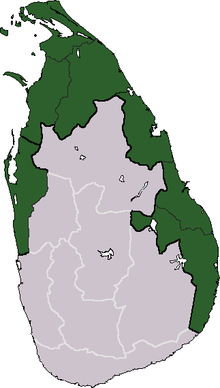Tamil Eelam: Difference between revisions
| Line 57: | Line 57: | ||
==See also== |
|||
* [[Flag of Tamil Eelam]] |
|||
* [[Eelam]] |
|||
* [[Self-determination]] |
|||
* [[Black July]] |
|||
* [[Sri Lankan Civil War]] |
|||
* [[Sri Lankan Tamil militant groups]] |
|||
==External links== |
==External links== |
||
Revision as of 03:31, 11 October 2007
This article's factual accuracy is disputed. |
| |||
 Area of Sri Lanka claimed for "Tamil Eelam" | |||
| Political status | Unrecognized state | ||
| Languages |
Tamil (de facto official) English | ||
| Capital | Trincomalee[1][2] (claimed) Kilinochchi (effective) | ||
| Independence (from Sri Lanka) |
No official declaration | ||
| Area |
19,509 km² claimed[3] | ||
| Population (of claimed area) |
3,162,254 (2001)[4] | ||
| Currency | Sri Lankan Rupee (LKR) | ||
| Time zone | UTC +5:30 | ||
| Calling Code | +94 | ||
Tamil Eelam (Tamil: தமிழ் ஈழம், tamiḻ īḻam) is the name given by Tamil separatists to the independent state to which they aspire in the Northern and Eastern portions of the island of Sri Lanka. One group, the Liberation Tigers of Tamil Eelam (LTTE) currently administers some of the land claimed for Tamil Eelam. This includes the entire district of Kilinochchi, most of the district of Mullaitivu and parts of the districts of Mannar and Vavuniya. However a majority of the land, including the claimed districts of Jaffna, Ampara, Trincomalee, Batticaloa and Puttlam, is controlled by the government of Sri Lanka.
Central issue
The concept of Eelam or homeland is a central issue in the Sri Lankan conflict that has been under way for more than five decades. It was first proposed by the Tamil United Liberation Front (TULF) in 1976. The TULF was a coalition of Tamil parties who campaigned in the 1977 elections for an independent state for Tamils in Sri Lanka. In the 1977 elections the TULF was elected to parliament from the northern and eastern provinces. In order to counter separatist tendencies, the government added a new clause to the constitution in 1978 requiring all MPs to pledge allegiance to the unity of the state, which resulted in the boycott of the parliament by the TULF. A number of militant groups then emerged fighting for an independent state.
As used by both the TULF and the militant groups, Tamil Eelam has only referred to the northeasterly portions of Sri Lanka (principally, the districts of Jaffna, Kilinochchi and Mullaitivu, claimed by Tamils as being their traditional homeland. Some of the early militant groups such as the EPRLF, however, adhered to a wider concept of Eelam, by which they meant all parts of the island of Sri Lanka with a Tamil majority, including the upcountry districts with an estate Tamil majority, traditionally part of the Sinhalese heartland. For all practical purposes today, though, the demand for an independent state is limited to the northern and eastern provinces.
From 1948 to 2002 there have been approximately 38 militant groups who have at one time or another fought for Tamil Eelam's independence. This number includes the better known groups such as the LTTE (Liberation Tigers of Tamil Eelam, also known as the Tamil Tigers), Tamil Eelam Liberation Organization (TELO), Eelam People's Revolutionary Liberation Front (EPRLF), People's Liberation Organisation of Tamil Eelam (PLOTE), Eelam Revolutionary Organisation of Students (EROS), and also lesser-known groups such as Tamil Eelam Army (TEA), Ilankai Freedom Tamil Army (FTA), and Socialist Revolutionary Social Liberation (SRSL).
Opponents of Tamil separatism have accused the Tamils of wanting to create an apartheid state; the Australian Centre for Sri Lankan Unity has stated that Tamil separatists wish to create an "apartheid-style state called 'Tamil Eelam'", and that attempts at devolution are examples of "apartheid and racism".[5]
External links
References
- ^ TamilCanadian, [1]
- ^ "A",[2]
- ^ Area calculated from statoids.com, including all districts of North Eastern Province and Puttalam District in North Western Province.
- ^ According to the 2001 Sri Lankan census, for all districts of North Eastern Province and Puttalam District in North Western Province.
- ^ The Devolution Law of Sri Lanka "A Critique", Australian Centre for Sri Lankan Unity, publication no. 25b.
